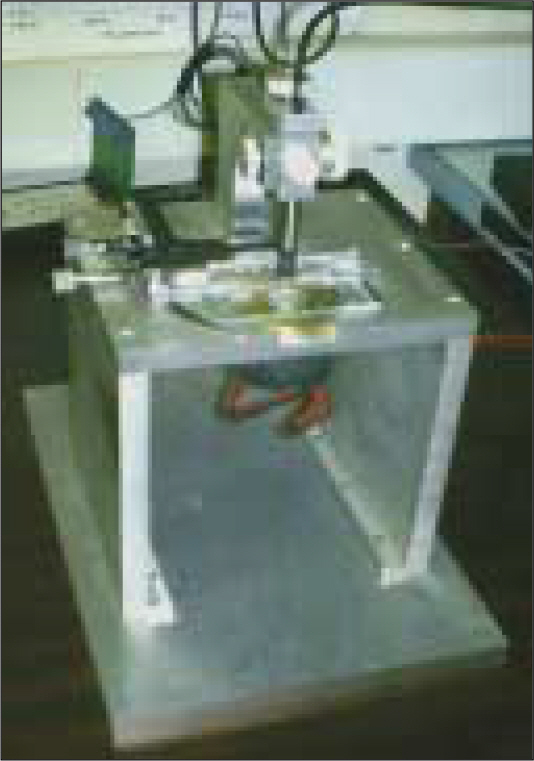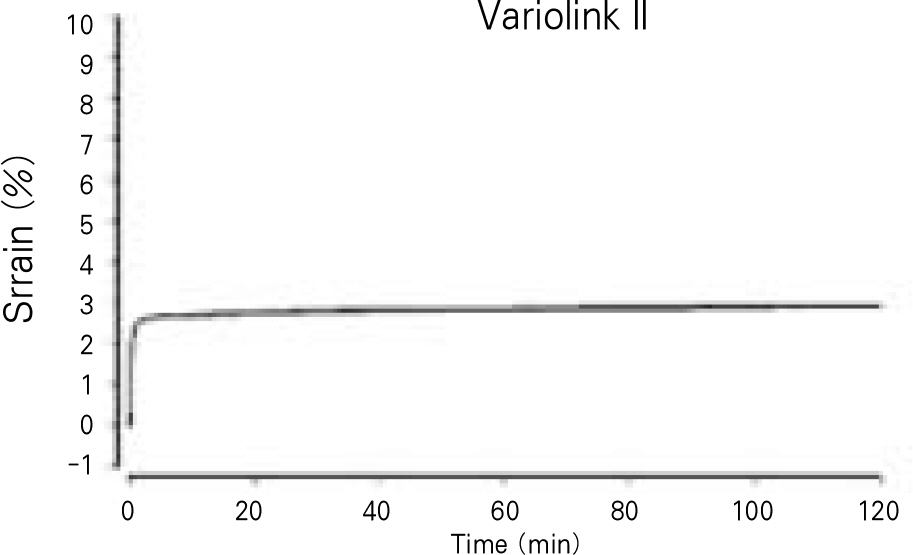J Korean Acad Prosthodont.
2010 Jan;48(1):55-60. 10.4047/jkap.2010.48.1.55.
In vitro study of Polymerization shrinkage-strain kinetics of dental resin cements
- Affiliations
-
- 1School of Dentistry, Seoul National University, Seoul, Korea.
- 2Department of Prosthodontics, Seoul National University Dental Hospital, Seoul, Korea. ksh1250@snu.ac.kr
- KMID: 2000321
- DOI: http://doi.org/10.4047/jkap.2010.48.1.55
Abstract
- PURPOSE
The shrinkage of dental resin cement may cause several clinical problems such as distortion that may jeopardize the accurate fit to the prepared tooth and internal stress within the restorations. It is important to know the polymerization shrinkage-strain of dental resin cement to reduce clinical complications. The purpose of this study was to investigate the polymerization shrinkage-strain kinetics of six commercially available dental resin cements. MATERIAL AND METHODS: Three self-cure resin cements (Fujicem, Superbond, M-bond) and three dual-cure resin cements (Maxcem, Panavia-F, Variolink II) were investigated. Time dependent polymerization shrinkage-strain kinetics of the materials were measured by the Bonded-disk method as a function of time at 23degrees C with values particularly noted at 1, 5, 10, 30, 60, 120 min after mixing. Five recordings were taken for each materials. The data were analyzed with one-way ANOVA and Scheffe post hoc test at the significance level of 0.05.
RESULTS
Polymerization shrinkage-strain values were 3.72%, 4.19%, 4.13%, 2.44%, 7.57%, 2.90% for Fujicem, Maxcem, M bond, Panavia F, Superbond, Variolink II, respectively at 120 minutes after the start of mixing. Panavia F exhibited maximum polymerization shrinkage-strain values, but Superbond showed minimum polymerization shrinkage-strain values among the investigated materials (P < .05). There was no significant differences of shrinkage-strain value between Maxcem and M bond at 120 minutes after the start of mixing (P > .05). Most shrinkage of the resin cement materials investigated occurred in the first 30 minutes after the start of mixing.
CONCLUSION
The onset of polymerization shrinkage of self-cure resin cements was slower than that of dual-cure resin cements after mixing, but the net shrinkage strain values of self-cure resin cements was higher than that of dual-cure resin cements at 120 minutes after mixing. Most shrinkage of the dental resin cements occurred in the first 30 minutes after mixing.
MeSH Terms
Figure
Reference
-
1.Davidson CL., de Gee AJ. Relaxation of polymerization con-tractionstresses by flow in dental composites. J Dent Res. 1984. 63:146–8.2.Puckett AD., Smith R. Method to measure the polymerization shrinkage of light-cured composites. J Prosthet Dent. 1992. 68:56–8.
Article3.Suliman AH., Boyer DB., Lakes RS. Polymerization shrinkage of composite resins: comparison with tooth deformation. J Prosthet Dent. 1994. 71:7–12.
Article4.Lee IB., Cho BH., Son HH., Um CM. A new method to measure the polymerization shrinkage kinetics of light cured composites. J Oral Rehabil. 2005. 32:304–4.
Article5.Kim SH., Watts DC. Polymerization shrinkage-strain kinetics of temporary crown and bridge materials. Dent Mater. 2004. 20:88–95.
Article6.Feilzer AJ., de Gee AJ., Davidson CL. Curing contraction of composites and glass ionomer cements. J Prosthet Dent. 1988. 59:297–300.7.Rees JS., Jacobsen PH. The polymerization shrinkage of composite resins. Dent Mater. 1989. 5:41–4.
Article8.Watts DC., Cash AJ. Determination of polymerization shrinkage kinetics in visible-light-cured materials: methods development. Dent Mater. 1991. 7:281–7.
Article9.Cook WD., Forrest M., Goodwin AA. A simple method for the measurement of polymerization shrinkage in dental composites. Dent Mater. 1999. 15:447–9.
Article10.Smith DL., Schoonover IC. Direct filling resins: dimensional changes resulting from polymerization shrinkage and water sorption. J Am Dent Assoc. 1953. 46:540–4.
Article11.Bowen RL. Properties of a silica-reinforced polymer for dental restorations. J Am Dent Assoc. 1963. 66:57–64.
Article12.Dennison JB., Craig RG. Physical properties and finished surface texture of composite restorative resins. J Am Dent Assoc. 1972. 85:101–8.
Article13.Bandyopadhyay SA. A study of the volumetric setting shrinkage of some dental materials. J Biomed Hater Res. 1982. 16:135–44.
Article14.Goldman M. Polymerization shrinkage of resin-bonded restorative materials. Aust Dent J. 1983. 28:156–61.15.Suh BI., Feng L., Wang Y., Cripe C., Cincione F., de Rjik W. The effect of the pulse delay cure technique on residual strain in composites. Compendium. 1999. 20:4–14.16.de Gee AJ., Feilzer AJ., Davidson CL. True linear polymerization shrinkage of unfilled resins and composites determined with a linometer. Dent Mater. 1993. 9:11–4.
Article17.Watts DC., Marouf AS. Optimal specimen geometry in bonded-disk shrinkage-strain measurements on light-cured biomaterials. Dent Mater. 2000. 16:447–51.
Article18.Venhoven BAM., de Gee AJ., Davidson CL. Polymerization contraction and conversion of light-curing BisGMA-based methacrylate resins. Biomaterials. 1993. 14:871–5.
Article19.Bandyopadhyay SA. A study of the volumetric setting shrinkage of some dental materials. J Biomed Mater Res. 1982. 16:135–44.
Article20.Hay JN., Shortall AC. Polymerization contraction and reaction kinetics of three chemically activated restorative resins. J Dent. 1988. 16:172–6.
Article21.Wall AWG., Mccabe JF., Murray JJ. The polymerization contraction of visible-light activated composite resins. J Dent. 1988. 16:77–81.22.Silikas N., Al-Kheraif A., Watts DC. Influence of P/L ratio on shrinkage-strain kinetics during setting of PMMA/MMA biomaterial formulations. Biomaterials. 2005. 26:197–204.23.Turner RC., Atkins PE., Ackley MA., Park JB. Molecular and macroscopic properties of PMMA bone cement: Free radical feneration and temperature change versus mixing ratio. J Biomed Mater Res. 1981. 15:425–32.24.Lang NP., Kiel RA., Anderhalden K. Clinical and microbiological effects of subgingival restorations with overhanging or clinically perfect margins. J Clin Periodintol. 1983. 10:563–78.
Article25.Sorensen SE., Larsen IB., Jorgensen KD. Gingival and alveolar bone reaction to marginal fit of subgingival crown margins. Scand J Dent Res. 1986. 94:109–14.
Article26.Felton DA., Kanoy BE., Bayne SC., Wirthman GP. Effect of in vivo crown margin discrepancies on periodontal health. J Prosthet Dent. 1991. 65:357–64.
- Full Text Links
- Actions
-
Cited
- CITED
-
- Close
- Share
- Similar articles
-
- Effects of immediate and delayed light activation on the polymerization shrinkage-strain of dual-cure resin cements
- Comparison of polymerization shrinkage of dual-cure core build-up resin according to shade and curing mode
- The effect of monomer to powder ratio on polymerization shrinkage-strain kinetics of polymer-based provisional crown and fixed partial denture materials
- Evaluation of polymerization shrinkage stress in silorane-based composites
- Polymerization shrinkage, hygroscopic expansion and microleakage of resin-based temporary filling materials








